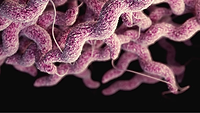Snapshot of Foodborne Pathogens in Scotland for 2020–2021

Credit: Public Health Scotland (PHS)
Public Health Scotland (PHS) has released its first biennial report on gastrointestinal and zoonotic pathogens, covering the years 2020–2021.
The report presents data from clinical diagnostic and reference laboratories, provided to PHS through the Electronic Communication of Surveillance in Scotland (ECOSS). ECOSS is a national tool for monitoring microorganisms and infections of clinical or public health importance.
According to the report, Campylobacter is the most common bacterial cause of infectious intestinal disease in Scotland. In 2020 and 2021, PHS received 5,392 and 5,890 laboratory reports of Campylobacter, respectively. Laboratory reports peaked in the spring and summer months. Moreover, in 2020, the overall incidence rate—which is the number of laboratory reports per 100,000 population—of Campylobacter in Scotland was 98.6, compared with 107.8 in 2021. Although Campylobacter is the most common bacterial cause of infectious intestinal disease, no general outbreaks were identified in 2020 or 2021, suggesting that most cases are sporadic.
Cyclosporiasis is a diarrheal disease caused by to the parasite Cyclospora cayetanensis. In 2020, PHS received four laboratory reports of Cyclospora, and in 2021, one report. Both 2020 and 2021 show a decrease on the 16 laboratory reports in 2019.
Regarding Shiga toxin-producing Escherichia coli (STEC) O157, PHS received 113 and 137 laboratory reports in 2020 and 2021, respectively. Both 2020 and 2021 show a decrease compared to the 149 laboratory reports in 2019, maintaining a declining trend in case numbers when comparing the most recent five years to the previous 5-year period. Most isolates were reported in the summer months. In 2020, the overall incidence rate of STEC O157 in Scotland was 2.1, compared with 2.5 in 2021.
The report discusses non-O157 STEC separately from STEC O157. In 2020, PHS received 100 laboratory reports of non-O157 STEC, and in 2021, 122 reports. Most reports were received in the summer. In 2020, the overall incidence rate of non-O157 STEC in Scotland was 1.8, compared with 2.1 in 2021. In 2020–2021 nine outbreaks of STEC were reported, four of which were reported in 2020 and are believed to have been foodborne.
In 2020 and 2021, PHS received 13 and 17 laboratory reports of Listeria monocytogenes, respectively. Both 2020 and 2021 show an increase compared to the 7 laboratory reports received in 2019. L. monocytogenes reports show no seasonality. In 2021, Scotland experienced two L. monocytogenes outbreaks.
Norovirus was reported 211 and 349 times in 2020 and 2021, respectively. Both 2020 and 2021 show a decrease on the 885 laboratory reports received in 2019. Additionally, the typical winter season trend was not seen in 2020 and 2021. In 2020, the overall incidence rate of norovirus in Scotland was 3.9, compared with 6.4 in 2021.
The report differentiates typhoidal Salmonella from non-typhoidal Salmonella. In 2020 and 2021, PHS received five and seven reports of typhoidal Salmonella, respectively.
Regarding non-typhoidal Salmonella, PHS received 342 and 330 laboratory reports in 2020 and 20201, respectively. Both 2020 and 2021 showed a decrease on the 757 laboratory reports received in 2019. Typical summer and October seasonal trends were not seen in 2020–2021. In 2020, the overall incidence of human non-typhoidal Salmonella in Scotland was 6.3, compared with 6.0 in 2021. The two most reported serotypes remain S. Enteritidis and S. Typhimurium.
In 2020–2021 there were 12 salmonellosis outbreaks involving different strains identified by whole genome sequencing (WGS) analysis. The outbreaks are believed to have been caused by food; ten of the outbreaks were UK-wide and two were local to Scotland. Since October 2017, WGS analysis of all Salmonella isolates has been routine practice in Scotland.
Looking for a reprint of this article?
From high-res PDFs to custom plaques, order your copy today!








